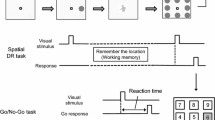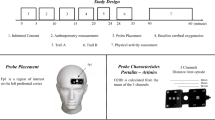Abstract
Purpose
To assess the relationship between exercise intensity, cerebral HbO2 and cognitive performance (Executive and non-Executive) in young adults.
Methods
We measured reaction time (RT) and accuracy, during a computerized Stroop task, in 19 young adults (7 males and 12 females). Their mean ± SD age, height, body mass and body mass index (BMI) were 24 ± 4 years, 1.67 ± 0.07 m, 72 ± 14 kg and 25 ± 3 kg m−2, respectively. Each subject performed the Stroop task at rest and during cycling at exercise of low intensity [40 % of peak power output (PPO)], moderate intensity (60 % of PPO) and high intensity (85 % of PPO). Cerebral oxygenation was monitored during the resting and exercise conditions over the prefrontal cortex (PFC) using near-infrared spectroscopy (NIRS).
Results
High-intensity exercise slowed RT in both the Naming (p = 0.04) and the Executive condition (p = 0.04). The analysis also revealed that high-intensity exercise was associated with a decreased accuracy when compared to low-intensity exercise (p = 0.021). Neuroimaging results confirm a decrease of cerebral oxygenation during high-intensity exercise in comparison to low- (p = 0.004) and moderate-intensity exercise (p = 0.003). Correlations revealed that a lower cerebral HbO2 in the prefrontal cortex was associated with slower RT in the Executive condition only (p = 0.04, g = −0.72).
Conclusion
Results of the present study suggest that low to moderate exercise intensity does not alter Executive functioning, but that exercise impairs cognitive functions (Executive and non-Executive) when the physical workload becomes heavy. The cerebral HbO2 correlation suggests that a lower availability of HbO2 was associated with slower RT in the Executive condition only.



Similar content being viewed by others
Abbreviations
- ANOVA:
-
Analysis of variance
- BMI:
-
Body mass index
- C02 :
-
Carbon dioxide
- CBF:
-
Cerebral blood flow
- CBF:
-
Cerebral blood flow
- fNIRS:
-
Functional near-infrared spectroscopy
- GLM:
-
General linear model
- HbO:
-
Oxy-hemoglobin
- HbR:
-
Deoxy-hemoglobin
- HbT:
-
Total hemoglobin
- HPF:
-
High pass filter
- MICE:
-
Moderate-intensity continuous exercise
- NIRS:
-
Near-infrared spectroscopy
- PaCO2 :
-
CO2 arterial pressure
- PFC:
-
Prefrontal cortex
- PPO:
-
Peak power output
- Ra:
-
Respiratory alkalosis
- RA:
-
Respiratory acidosis
- RCT:
-
Respiratory compensation threshold
- RT:
-
Reaction time
- SD:
-
Standard deviation
- THT:
-
Transient hypofrontality theory
- \( \dot{V}{\text{O}}_{2} \) :
-
Oxygen uptake
- W:
-
Watts
References
Ando S, Kokubu M et al (2011) Does cerebral HbO2 affect cognitive function during exercise? Eur J Appl Physiol 111(9):1973–1982
Audiffren M, Tomporowski PD et al (2009) Acute aerobic exercise and information processing: modulation of executive control in a random number generation task. Acta Psychol (Amst) 132(1):85–95
Bhambhani Y, Malik R et al (2007) Cerebral oxygenation declines at exercise intensities above the respiratory compensation threshold. Respir Physiol Neurobiol 156(2):196–202
Bohnen N, Twijnstra A, Jolles J (1992) Performance in the Stroop color word test in relationship to the persistence of symptoms following mild head injury. Acta Neurol Scand 85(2):116–121
Brisswalter J, Collardeau M et al (2002) Effects of acute physical exercise characteristics on cognitive performance. Sports Med 32(9):555–566
Chmura J, Nazar K, Kaciuba-Uscilko H (1994) Choice reaction time during graded exercise in relation to blood lactate and plasma catecholamine thresholds. Int J Sports Med 15(4):172–176
Cohen J (1988) Statistical power analysis for the behavioral sciences, 2nd edn. L Erlbaum Associates, Hillsdale
Colcombe SJ, Kramer AF et al (2004) Neurocognitive aging and cardiovascular fitness: recent findings and future directions. J Mol Neurosci 24(1):9–14
Dietrich A (2003) Functional neuroanatomy of altered states of consciousness: the transient hypofrontality hypothesis. Conscious Cogn 12(2):231–256
Dietrich A, Audiffren M (2011) The reticular-activating hypofrontality (RAH) model of acute exercise. Neurosci Biobehav Rev 35(6):1305–1325
Dietrich A, Sparling PB (2004) Endurance exercise selectively impairs prefrontal-dependent cognition. Brain Cogn 55(3):516–524
Dupuy O, Lussier M, Fraser S, Bherer L, Audiffren M, Bosquet L (2014) Effect of overreaching on cognitive performance and related cardiac autonomic control. Scand J Med Sci Sports 24(1):234–242
Dupuy O, Gauthier CJ, Fraser SA, Desjardins-Crepeau L, Desjardins M, Mekary S, Bherer L (2015) Higher levels of cardiovascular fitness are associated with better executive function and prefrontal oxygenation in younger and older women. Front Hum Neurosci 9:66
Ekkekakis P (2009) Illuminating the black box: investigating prefrontal cortical hemodynamics during exercise with near-infrared spectroscopy. J Sport Exerc Psychol 31(4):505–553
Gonzalez-Alonso J, Dalsgaard MK et al (2004) Brain and central haemodynamics and oxygenation during maximal exercise in humans. J Physiol 557(Pt 1):331–342
Labelle V, Bosquet L, Mekary S, Bherer L (2013) Decline in executive control during acute bouts of exercise as a function of exercise intensity and fitness level. Brain Cogn 81(1):10–17
Lucas SJ, Tzeng YC et al (2010) Influence of changes in blood pressure on cerebral perfusion and oxygenation. Hypertension 55(3):698–705
McMorris T, Graydon J (1997) The effect of exercise on cognitive performance in soccer-specific tests. J Sports Sci 15(5):459–468
McMorris T, Tallon M et al (2003) Incremental exercise, plasma concentrations of catecholamines, reaction time, and motor time during performance of a noncompatible choice response time task. Percept Mot Skills 97(2):590–604
McMorris T, Davranche K, Jones G, Hall B, Corbett J, Minter C (2009a) Acute incremental exercise, performance of a central executive task, and sympathoadrenal system and hypothalamic-pituitary-adrenal axis activity. Int J Psychophysiol 73(3):334
McMorris Terry, Tomporowski Phillip D, Audiffren Michel (2009b) Exercise and cognitive function. Willey, Oxford
Ogoh S, Nakahara H et al (2010) The effect of oxygen on dynamic cerebral autoregulation: critical role of hypocapnia. J Appl Physiol 108(3):538–543
Pesce C, Cereatti L et al (2007a) Preservation of visual attention in older expert orienteers at rest and under physical effort. J Sport Exerc Psychol 29(1):78–99
Pesce C, Tessitore A et al (2007b) Focusing of visual attention at rest and during physical exercise in soccer players. J Sports Sci 25(11):1259–1270
Pontifex MB, Hillman CH (2007) Neuroelectric and behavioral indices of interference control during acute cycling. Clin Neurophysiol 118(3):570–580
Prakash RS, Voss MW, Erickson KI, Lewis JM, Chaddock L, Malkowski E, Kramer AF (2011) Cardiorespiratory fitness and attentional control in the aging brain. Front Hum Neurosci 4:229
Querido JS, Sheel AW (2007) Regulation of cerebral blood flow during exercise. Sports Med 37(9):765–782
Rooks CR, Thom NJ et al (2010) Effects of incremental exercise on cerebral HbO2 measured by near-infrared spectroscopy: a systematic review. Prog Neurobiol 92(2):134–150
Strangman G, Franceschini MA, Boas DA (2003) Factors affecting the accuracy of near-infrared spectroscopy concentration calculations for focal changes in oxygenation parameters. Neuroimage 18(4):865–879
Subudhi AW, Dimmen AC et al (2007) Effects of acute hypoxia on cerebral and muscle oxygenation during incremental exercise. J Appl Physiol 103(1):177–183
Yanagisawa H, Dan I et al (2010) Acute moderate exercise elicits increased dorsolateral prefrontal activation and improves cognitive performance with Stroop test. Neuroimage 50(4):1702–1710
Ye JC, Tak S, Jang KE, Jung J, Jang J (2009) NIRS-SPM: statistical parametric mapping for near-infrared spectroscopy. Neuroimage 44(2):428–447
Conflict of interest
The authors of this paper have no conflicts of interest.
Author information
Authors and Affiliations
Corresponding author
Additional information
Communicated by Toshio Moritani.
Rights and permissions
About this article
Cite this article
Mekari, S., Fraser, S., Bosquet, L. et al. The relationship between exercise intensity, cerebral oxygenation and cognitive performance in young adults. Eur J Appl Physiol 115, 2189–2197 (2015). https://doi.org/10.1007/s00421-015-3199-4
Received:
Accepted:
Published:
Issue Date:
DOI: https://doi.org/10.1007/s00421-015-3199-4




